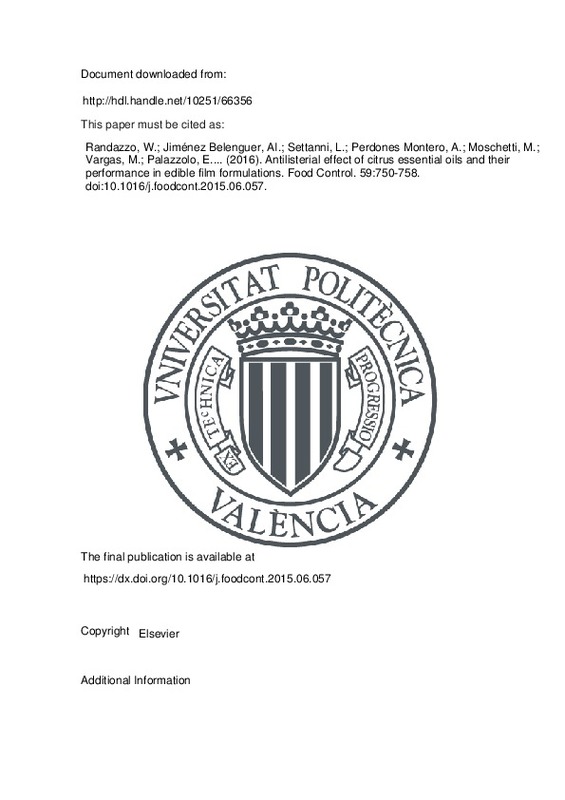JavaScript is disabled for your browser. Some features of this site may not work without it.
Buscar en RiuNet
Listar
Mi cuenta
Estadísticas
Ayuda RiuNet
Admin. UPV
Antilisterial effect of citrus essential oils and their performance in edible film formulations
Mostrar el registro sencillo del ítem
Ficheros en el ítem
| dc.contributor.author | Randazzo, Walter
|
es_ES |
| dc.contributor.author | Jiménez Belenguer, Ana Isabel
|
es_ES |
| dc.contributor.author | Settanni, Luca
|
es_ES |
| dc.contributor.author | Perdones Montero, Ángela
|
es_ES |
| dc.contributor.author | Moschetti, Marta
|
es_ES |
| dc.contributor.author | Palazzolo, Eristanna
|
es_ES |
| dc.contributor.author | Guarrasi, Valeria
|
es_ES |
| dc.contributor.author | Vargas Colás, Mª Desamparados
|
es_ES |
| dc.contributor.author | Germana, Maria Antonietta
|
es_ES |
| dc.contributor.author | Moschetti, Giancarlo
|
es_ES |
| dc.date.accessioned | 2016-06-23T07:43:12Z | |
| dc.date.available | 2016-06-23T07:43:12Z | |
| dc.date.issued | 2016-01 | |
| dc.identifier.issn | 0956-7135 | |
| dc.identifier.uri | http://hdl.handle.net/10251/66356 | |
| dc.description.abstract | [EN] The antimicrobial activity of eight essential oils (EOs) extracted from the fruit peel of Citrus genotypes (orange, mandarin and lemon) was evaluated against 76 strains of Listeria monocytogenes, previously isolated from different food matrices. EOs showing the most (EO L2 and EO L8) and least (EO O3 and EO M7) effective inhibition activities were chemically characterized by gas chromatography coupled with mass spectrometry (GC/MS) to compare their composition. EO L2 and EO L8 were chosen to determine the MIC and to evaluate the cell viability of the most sensitive strains (L. monocytogenes LM35 and LM69) after 1, 2, 4 and 6 h of exposure. The effectiveness of chitosan (CH) and methylcellulose (MC) edible films, alone and in combination with EO L2 and EO L8, was determined against LM35 and LM69 at 37 C for 0, 8 and 24 h and at 8 C for 0, 1, 3 and 7 days. In addition, the analysis of the microstructure of the films were performed by scanning electron microscope (SEM) to evidence the interactions between the polymers and EOs. Thirty-five and twenty-nine strains were clearly inhibited by EO L2 and EO L8, respectively, while the other Citrus EOs showed poor (EO M1, O4, O5, O6) or minimal (EO O3 and M7) antimicrobial activity. A total of 36 chemical volatile substances was identified by GC/MS to detect the compounds that might play an important role in the characterization of the EOs. The chemical characterization points to oxygenated monoterpenes as relevant compounds in inhibiting Listeria strains, since they have been detected in lemon EOs in concentrations four/five folds higher than orange EOs. Generally, CH- and MCbased films containing EO L2 and EO L8 showed antilisterial activities, even though, the best performances were observed in case of CH-films at 8 C, with a major reduction up to 3 log (CFU/cm2) in case of EO L2 incorporation. The microstructures observed by SEM suggested a better incorporation of the EOs in CH matrix, where a higher amount of oil droplets was distinguished. Therefore, lemon EOs incorporated into chitosan films could be an efficient tool to control Listeria monocytogenes, especially in refrigerated applied conditions. | es_ES |
| dc.description.sponsorship | WR was supported by the "Student Mobility for Placement - SMP" grant of the EU Life Learning Program. The authors thank the "Azienda Sperimentale Palazzelli C.R.A. - Centro di ricerca per l'agrumicoltura e le colture mediterranee Contrada Palazzelli Scordia" (CT, Italy) for providing some of the fruits used for EOs extractions. | en_EN |
| dc.language | Inglés | es_ES |
| dc.publisher | Elsevier | es_ES |
| dc.relation.ispartof | Food Control | es_ES |
| dc.rights | Reserva de todos los derechos | es_ES |
| dc.subject | Biopreservation | es_ES |
| dc.subject | Citrus | es_ES |
| dc.subject | Edible coating | es_ES |
| dc.subject | Essential oils | es_ES |
| dc.subject | GC/MS | es_ES |
| dc.subject | Listeria monocytogenes | es_ES |
| dc.subject.classification | MICROBIOLOGIA | es_ES |
| dc.subject.classification | TECNOLOGIA DE ALIMENTOS | es_ES |
| dc.title | Antilisterial effect of citrus essential oils and their performance in edible film formulations | es_ES |
| dc.type | Artículo | es_ES |
| dc.identifier.doi | 10.1016/j.foodcont.2015.06.057 | |
| dc.rights.accessRights | Abierto | es_ES |
| dc.contributor.affiliation | Universitat Politècnica de València. Departamento de Biotecnología - Departament de Biotecnologia | es_ES |
| dc.contributor.affiliation | Universitat Politècnica de València. Instituto Universitario de Ingeniería de Alimentos para el Desarrollo - Institut Universitari d'Enginyeria d'Aliments per al Desenvolupament | es_ES |
| dc.contributor.affiliation | Universitat Politècnica de València. Departamento de Tecnología de Alimentos - Departament de Tecnologia d'Aliments | es_ES |
| dc.description.bibliographicCitation | Randazzo, W.; Jiménez Belenguer, AI.; Settanni, L.; Perdones Montero, A.; Moschetti, M.; Palazzolo, E.; Guarrasi, V.... (2016). Antilisterial effect of citrus essential oils and their performance in edible film formulations. Food Control. 59:750-758. doi:10.1016/j.foodcont.2015.06.057 | es_ES |
| dc.description.accrualMethod | S | es_ES |
| dc.relation.publisherversion | https://dx.doi.org/10.1016/j.foodcont.2015.06.057 | es_ES |
| dc.description.upvformatpinicio | 750 | es_ES |
| dc.description.upvformatpfin | 758 | es_ES |
| dc.type.version | info:eu-repo/semantics/publishedVersion | es_ES |
| dc.description.volume | 59 | es_ES |
| dc.relation.senia | 291995 | es_ES |
| dc.identifier.eissn | 1873-7129 |







![[Cerrado]](/themes/UPV/images/candado.png)

